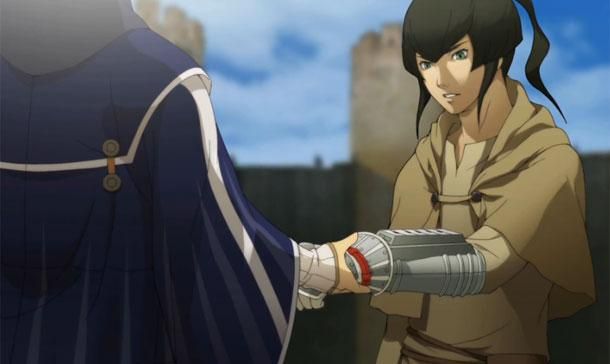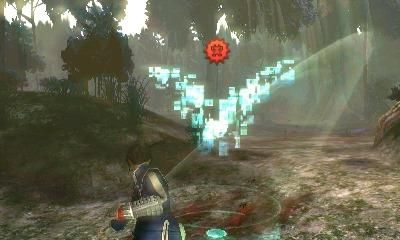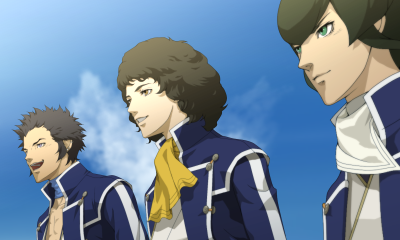When the game starts, you're treated to a somewhat trippy opening sequence that has the protagonist (and by extension the player) being lectured by mysterious beings about the important role they will play in shaping the world. After that, you choose the main character's name (his default one is Flynn) and then your adventure beings.
The protagonist and his friend, Issachar, travel to Mikado castle in order to participate in the Gauntlet Rite and become Samurai. You're given a chance to shoot the breeze with some of the people living in the capital on the way and although it's mostly pleasant, there's an underlying current of wrong in a few of the interactions. One that sticks out in my mind is a Craftsman man saying that "I'm not paid to use my brain. The Luxurors can do the thinking for me." For reference, the Luxurors are the nobles of sort and the Casualries (which is what the Craftsman was) are the regular working class.
After the protagonist officially becomes a Samurai (oh no, spoilers) and is given the mystical Gauntlet, he begins his training in Naraku, which is the hive of the demons. As you may have guessed, the mission of Samurai is to venture into Naraku and slay demons in order to prevent them from invading the Eastern Kingdom of Mikado. The Gauntlet you receive is like a smartphone in which you can install multiple Apps in order to better facilitate the process of demon hunting, recruiting and fusing. That's right, for all the new Megaten players out there, not only can you recruit demons to fight by your side, you can also fuse two or more demons to make even more powerful ones. The ability to recruit demons is crucial to your survival--so much so that the game forces you to purchase the App and recruit at least three demons in order to facilitate this.
Demonic recruitment, as any veteran of the Megaten series will tell you, is not as simple as asking for their aid. You must woo each demon by giving them items, money and/or answering their questions correctly. What makes the question answering difficult is that not only are there general right and wrong answers for all demons but there are specific answers depending on the demon's alliance (chaos, law or neutral) and their personality. If you answer incorrectly, your party loses all their turns and the enemy attacks but, unlike previous titles, you can try to communicate with them again on the protagonist's next turn.
After you procure your demons and form a proper party, the protagonist can learn skills from them through a process known as a Whisper Event. When a demon in either the active or reserve party (demons gain experience in reserves albeit more slowly) has learned all its possible skills, it can teach you how to use any of those skills. The demon will only be able to do this once and if your skill slots are all filled, you will have to delete one to fit another so be careful.
Another very interesting feature of SMT IV is that if you die, you don't immediately get a Game Over. Charon, the ferryman of the river Styx in the Underworld has decided, out of laziness and greed, to allow you to come back to life if you pay him in either Macca, Play Coins or put it on a tab. If you die for the first time and then die again, the second time you get a special scene in which you speak with Charon's two minions. They comment that their master isn't here and after busting your balls a bit, send you on your way, free of charge. Burroughs, the navigational AI contained in your Gauntlet, also gives you the option to switch the difficulty setting to Easy. Don't worry, you can switch the difficulty on the fly and with no penalty. And just so you know, if you choose to let Charon take your character's soul (or can't afford to pay him), you'll get the regular Game Over screen and be subjected to his severe bitching, so unless you're trying to troll him just pay if you can.
SMT IV uses the Press Turn System, which was last used in Nocturne and inspired the One More system in Persona 3 and 4. At the start of battle, the protagonist and his allies receive one turn each to act (for a maximum of four turns) before the enemy reacts. However, if you target and successfully hit an enemy's weakness, you get an additional turn for each time you do this. There's also a great and newly introduced status called Smirk that works hand in hand with this concept. If you land an attack that exploits a weakness, nullify an attack you have a resistance to or land a critical hit, that character may gain the Smirk status. This makes enemy attacks easier to avoid and your own hit ratio and attack strength increases greatly for that turn. Beware, though, because the enemy can use this system and status as well. The beauty of the Press Turn System is in its simplicity and strategic depth; for example, if you properly target enemy weaknesses, you can kill the enemy before they have the chance to launch a single attack.
The new dungeon style of SMT IV will take some getting used to since it has been switched from first-person to third person. This change would be of little concern if random encounters were still in place, but that's been changed too. Enemies appear in the dungeon as a blue unit and when the protagonist comes into contact with it, a battle ensues. You can also strike the enemy unit first to deal extra damage at the beginning of the battle but be careful because if the enemy gets the drop on you, they do the same (and it's not pretty). What makes dungeon crawling so legitimately frightening is that the only warning you have that an enemy is near is the sound they make, meaning you'd better turn the camera around because it either already spotted you or it's about to.
Now that I've given you a long-winded dissertation on gaming mechanics and aesthetics, I can go into the positives and negatives of the game itself.
To start positive, I love the character designs, which are done by newcomer Masayuki Doi, who previously worked on Trama Center: New Blood. The characters have the subdued maturity of Kazuma Kaneko's designs and the expressiveness of Shigenori Soejima's characters (Kaneko being the artist for most of the Megaten series and Soejima for Persona 3 and 4). Of course, Kaneko's demon designs still hold up well today and the new demon designs and redesigns look great as well.
I also really dig the whole digital interface in this game--it's an interesting blend of modern and archaic. The setting and the people are a beautiful mix of Medieval Europe and Feudal Japan. This kind of strange blend shouldn't work but every time I look around Mikado, I'm amazed Doi and the visual team managed to pull it off. The 3D environments are also well rendered with a smooth frame rate and a nifty visual treat of seeing the protagonist physically wearing his equipment in the field.
Last but not least, I didn't have any issues with the voice acting. While it's not always top notch, when the emotional scenes come, everyone steps up to the plate. Then of course some voices are just stellar throughout, like Navarre, Burroughs, Abbot Hugo and any of the demon bosses you face.
The music is somewhat surprisingly not composed by Shoji Meguro (the main composer for Persona 3, 4, Catherine and the remakes of Persona 1 and 2) but by Ryota Kozuka and Kenichi Tsuchiya. Let me tell you that the soundtrack is nothing short of amazing; from the battle themes to the event music to even the world map music, this game is incredible to listen to.
In terms of gameplay, what's so refreshing is that, like Fire Emblem: Awakening, it's made to be accessible to first time players while somehow managing to be wonderfully challenging and strategic for hard core fans. I do wish that Bufu (Ice) skills still caused the Freeze ailment and Zio (Lightning) skills the Shock ailment but the idea of Zan (Wind) spells causing the Lost status is pretty neat.
One of the most important aspects of a Megaten game is the story and while I won't spoil anything, the plot avoids the pitfall of being a simple black and white fantasy tale. Instead, the plot and characters themselves are as mature and complex as you'd expect them to be, with many twists and surprises thrown in. The theme of choices with far-reaching consequences is both subtle but powerful and forces you to consider how your decisions will affect not only you but the world you live in and its people. As you can imagine, this is something very few games--especially JRPGs--actually manage to implement, and Atlus does it to great effect. (And all the shout-outs to the various Megaten games are a real treat to spot as well.)
All good things must come to an end, and with that I give you the negatives. First, I had a real problem with how much damage the enemy inflicts on my characters, especially in the beginning of the game. When you first enter Naraku, enemies can deal damage up to half the main character's HP, which becomes a major hurdle when he's all alone (basically until the end of the second quest) and is still an issue even when you finally form your party. Later on, the damage scale equals out but until then you have to be extremely careful.
One other issue I have deals with actually spotting the enemy in relation to you while in a dungeon or map. I wish there was a feature or App that allowed you to see enemy units near you on the map, so it would be easier to tell if one was behind you. While having to scan for foes manually as you pay close attention to their cries certainly heightens the suspense, in a game that allows enemies to get the jump on you and kill your party before you get a single turn, this makes any detection mistakes lead to your destruction. Yes I realize that you can come back to life but that costs money, money that you could be using for items and equipment (not to mention it's still frustrating). The only way to get around this is by paying with Play Coins instead.
There are a few features that are not present in Shin Megami Tensei IV which were staples of other Megaten games (such as moon phases, certain ailments, etc.) and vice versa (recruiting any demon in battle regardless of alignment, saving and fusing anywhere, picking inherited skills for your fused demons, etc.). However, these changes were very necessary, not only to bring in new players but to prevent the Megaten series from turning into an old relic. SMT IV is a well developed, immersive and highly polished game that has something for old and new fans alike.
Shin Megami Tensei IV
- Platform(s)
- 3DS
- Developer(s)
- Atlus
- Publisher(s)
- Atlus , Deep Silver
- Genre(s)
- JRPG







